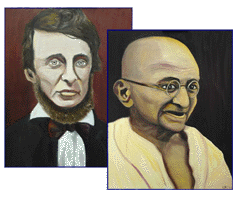"The whole aim of practical politics is to keep the populace alarmed (and hence clamorous to be led to safety) by menacing it with an endless series of hobgoblins, all of them imaginary." ~ H.L. Mencken
Condi in the Briar Patch
What we saw in the 9/11 Commission hearing with Condoleeza Rice is a brilliantly conceived and orchestrated exercise in reverse psychology. The major objective of the hearing (a cooperative effort between the administration represented by Rice and the commission itself supposedly representing the public) was to convince the public that, based on the 'intelligence' information it had, no one could have foreseen the use of hijacked commercial airliners in suicide attacks on U.S. landmarks. In order to guarantee the largest possible viewing audience for the televised and scripted 'show,' commission chair Thomas Kean announced it was asking Rice to appear at a public hearing under oath. Rice and the administration fought that, saying Rice would appear before the commission but not in public and not under oath. This led to a PR blitz in the media stoked by perceived Bush enemies and proponents of the "Bush knew in advance" theorists. Eventually the administration 'capitulated' and agreed to let Rice testify for two and a half hours before the commission in public and under oath. Those who remember the Uncle Remus stories of Joel Chandler Harris should recognize this ploy as coming straight out of his story about Brer Rabbit and the Tar Baby, where Brer Rabbit pleaded not to be thrown into the briar patch (his only sure avenue of escape). Brer Fox, intent on doing as much damage to Brer Rabbit as he could, then threw him into the briar patch, from which the wily Brer Rabbit scampered to safety. Rice was in trouble comparable to being stuck on the tar baby because of her widely quoted statement that no one (in the administration) could have imagined the use of commercial airplanes as missiles as was done on 9/11. She quickly backed off from that statement, saying she should have said 'I' couldn't have imagined that, explaining that several people had explained to her that at least some were aware of that kind of threat. Of course, she was never asked who those people were. Having whetted the public's appetite for what some saw as the 'public lynching' of Condi Rice, the TV networks then took the almost unheard of step of preempting all of their soaps to telecast the hearing live. The stage for the big show was set. To understand what unfolded during the hearing, the reader should be familiar with the 1995 three-phase terrorist plot code named 'Bojinka.' An exposition of the details of the plots and the background is available in this author's June 18, 2002 article 'Bojinka: The Dog That Didn't Bark.' Although that code name was not mentioned, the entire thrust of Rice's testimony and commission questioning was focused on denying any knowledge of the details of that plot concocted by Ramzi Yousef, convicted mastermind of the 1993 bombing of the WTC, who later planned to hijack commercial airlines and fly them into U.S. landmarks. Specifically named as targets in the documentation recovered by Philippine authorities (and furnished to the FBI, CIA and State Department in 1995) were the Pentagon, World Trade Center and the Sears Tower in Chicago. As called for in the script (each commissioner had a carefully prepared 'brief' from which most of the questions were taken), Richard Ben Veniste was chosen to apparently 'trap' Rice into admitting to the existence of an intelligence report that contained warnings of possible hijackings. He asked her to give the title of the President's daily briefing (PDB) presented to Bush on August 5, 2001 at his ranch in Texas by CIA Director George Tenet. Rice, feigning reluctance, disclosed the title as 'Bin Laden Determined to Attack Inside the United States.' Rice admitted that the document did mention the possibility of hijacked airliners but only in the context of obtaining hostages to trade for convicted terrorists. She maintained that throughout her testimony. Several commissioners and the Chair challenged Rice to have the PDB declassified. She would not commit to that. However, with remarkable speed, the White House declassified the PDB and copies appeared in the media by the weekend. Far from being the 'smoking gun' critics were expecting, the PDB backed Rice's testimony about potential hijackings to get hostages (from an uncorroborated and unidentified 'source'). However, the PDB did say that the FBI saw patterns of 'suspicious' activity in the country consistent with preparations for hijackings. Over the period of five years, from 1996 to 2001, the FBI made numerous inquiries about suspected bin Laden associates taking pilot training in at least four flight schools in Arizona, Texas, Oklahoma and Florida. The last inquiry took place at the Airman Flight School in Norman, Oklahoma just three weeks before the Sept. 11 disaster. The administration has admitted that during the summer of 2001, many reports of a catastrophic terrorist strike were circulating. While the taking of hostages hardly qualifies as "catastrophic," anyone familiar with the details of the third phase of the Bojinka plot would have immediately recognized the preparations to execute it. Who should have recognized the threat? Certainly Richard Clarke, who supervised John O'Neill, the FBI's Al Quaeda expert in New York who was involved in the capture and prosecution of Ramzi Yousef for the first phase of Bojinka to blow up 11 airliners simultaneously over the Pacific. Clarke admitted as much when he said analysts should be forgiven for 'forgetting' about the plot, which was six years old. Also, DIA Director Tenet and Commission member Jamie Gorelick almost certainly knew about Bojinka. From March 1994 until she joined Fannie Mae in May 1997, Gorelick was Deputy Attorney General, the number two spot in Janet Reno's Department of Justice. In May 1995, the Intelligence Community Law Enforcement Policy Board was established to meet quarterly and discuss mutual concerns of the Attorney General and Director of Central Intelligence. The board was co-chaired by Gorelick and DCI George Tenet. Other members included all of the law enforcement agencies, the Assistant Secretary of State for Intelligence and Research and the Defense Department General Counsel. This is the same time frame (spring of 1995) in which the Philippine government apprised the FBI, CIA and State Department of 'Project Bojinka,' an Islamic terrorist plot that included hijacking commercial airlines and flying them into the Pentagon, World Trade Center towers and several other buildings. It beggars belief that Bojinka was not discussed at that meeting, especially since one part of the plot was to fly an explosive-laden small plane (not a hijacked airliner) into CIA headquarters. That should have gotten Tenet's attention. In another unprecedented step, the White House released a transcript of the 42-minute 'background' briefing given selected reporters shortly after the conclusion of the Rice hearing. It emphasized several times that the only mention of hijacking was in the context of obtaining hostages. Since 9/11, the insiders' propaganda and disinformation assets in the New York Times and Washington Post have brazenly maintained that project Bojinka did not include hijacking commercial airliners to fly them into U.S. landmarks. For instance, Mathew Brzezinski, the Washington Post's intelligence expert (nephew of Zbigniew Brzezinski), published the following: 'No one imagined something like this possible, and there was no US precedent to justify heightened security. Bojinka was about blowing planes up, not hijacking them.' Nicholas D. Kristof, intelligence 'expert' for the New York Times, published a full-length article that was syndicated widely to other newspapers purporting to explain Operation Bojinka, which entirely omitted the third phase about the hijacking of airliners. So far, the media, government, and the 911 commission have succeeded in 'dodging the bullet.' Before the commission ends its 'mandate' and issues its report the public, the families of the victims of 9/11 should demand the commission obtain answers from the relevant officials (as well as commissioner Jamie Gorelick) in the format made famous by Howard Baker in the Watergate hearings, 'What did they know about Bojinka and when did they know it?'








 Reprint Rights
Reprint Rights